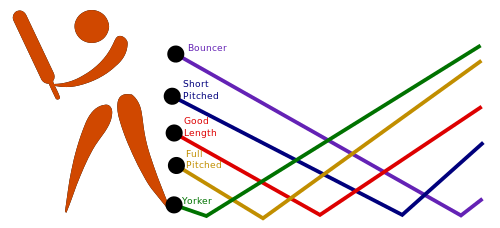
Common Cricket Terminologies: A Guide for Beginners
Introduction to Cricket
Cricket is a popular sport played with a bat and ball on a large oval field. Understanding the cricket terminology used in cricket is essential for newcomers to enjoy and follow the game. Here are some key terms to get you started:
- Batsman: The player who hits the ball delivered by the bowler.
- Bowler: The player who delivers the ball to the batsman.
- Wicket: The set of three stumps and two bails that the batsman defends to prevent the ball from hitting and dislodging them.
- Run: Points scored by the batsmen by hitting the ball and running between the wickets.
- Boundary: The edge of the cricket field; hitting the ball beyond this results in four runs (grounded) or six runs (over the boundary).
- Over: A set of six legal deliveries bowled by one bowler.
- Innings: The period during which one team bats and the other bowls.
- Umpire: The official who enforces the rules of the game, makes decisions, and presides over the match.
- Crease: The lines near the stumps which the batsman must stay within to avoid being run out.
- LBW (Leg Before Wicket): A way of getting out in which the ball hits the batsman’s leg, and the umpire deems it would have hit the stumps if the leg was not in the way.
Basic Rules and Gameplay
- Cricket is a bat-and-ball sport played between two teams of eleven players each.
- The game consists of innings, with each team taking turns to bat and field.
- The team that scores the most runs wins the match.
- A run is scored by the batsmen running between the wickets after hitting the ball.
- The fielding team aims to dismiss the batsmen by various means, such as catching the ball, hitting the stumps with the ball, or trapping the batsman in front of the wicket.
- A bowler delivers the ball towards the batsman, who tries to score runs without getting out.
- The batting team can have two batsmen on the field at a time, while the fielding team has all eleven players involved.
- The pitch is the strip of closely mown grass where the action takes place, with the batsmen at one end and the bowler at the other.
- The wickets are the three vertical stumps at each end of the pitch, topped by two bails. The batsmen aim to protect these wickets while scoring runs.
- Runs can also be scored by hitting boundaries, either by hitting the ball to the fence along the ground or clearing the boundary in the air for a six.
- Fielding positions include positions like slip, gully, point, mid-off, mid-on, mid-wicket, fine leg, and deep square leg.
- A match can last several hours to multiple days, depending on the format being played—Test matches, One Day Internationals (ODIs), or Twenty20 (T20) games.
Keep these basic rules in mind to understand the gameplay better as you delve further into the world of cricket.
Cricket Equipment
In cricket, having the right equipment is crucial for a player’s performance and safety. Here are some common cricket terminology associated with equipment:
- Bat: The primary offensive weapon used by a batsman to score runs. Bats come in various sizes and weights to suit different player preferences.
- Ball: A hard leather ball used in cricket matches. It is typically red for Test matches and white for limited-overs matches.
- Stumps: Three vertical wooden posts that are the target for the bowler to hit. The stumps are topped by two bails, and if dislodged, the batsman is considered out.
- Pads: Protective gear worn by batsmen to protect their legs from injury when facing fast bowlers. Pads are usually made of foam and are strapped onto the legs.
- Helmet: A protective headgear worn by batsmen and fielders fielding close to the batsman. Helmets are essential for safety when facing fast bowlers.
- Gloves: Worn by batsmen to protect their hands and provide better grip on the bat. Gloves are padded to absorb the impact of fast bowling.
- Guard: A mark made by the batsman on the pitch to indicate their preferred stance. Guards help batsmen position themselves correctly before facing the bowler.
- Kit Bag: A large bag used to carry all cricket equipment, including bats, pads, helmet, gloves, and clothing. It is essential for keeping equipment organized and easy to transport.
Field Positions and Their Roles
In cricket, fielding is a crucial element of the game, with players strategically positioned around the field to support the bowler and limit the batsmen’s scoring opportunities. Understanding the various field positions and their roles is essential for both players and spectators. Here are some common field positions and their roles:
- Slip: Positioned behind the batsman on the off side, slips are placed to catch an edged ball. They require quick reflexes and good hands to take catches.
- Gully: Similar to slips, gully fielders also stand behind the batsman but more square of the wicket. They are there to catch balls that are edged wide of the slips.
- Third Man: Positioned behind the batsman on the off side, near the boundary. Third man is often placed to stop runs from edged shots played towards the boundary.
- Fine Leg: Positioned square of the wicket on the leg side, fine leg is placed to catch shots that are flicked off the batsman’s pads.
- Mid-Wicket: Positioned on the leg side, between square leg and mid-on. Mid-wicket fielders are there to field shots played towards the leg side by the batsman.
- Cover: Positioned on the off side, cover fielders cover drives and shots played square of the wicket on the off side.
- Long Off/Long On: Placed near the boundary on the off side and leg side respectively. They aim to retrieve shots hit straight down the ground.
- Deep Square Leg/Deep Fine Leg: Fielders placed near the boundary behind square leg and fine leg respectively to catch big shots played in those areas.
Scoring in Cricket
In cricket, scoring refers to the accumulation of runs by the batting team. Understanding how scoring works is essential for both players and spectators. Here are some key terms related to scoring in cricket:
- Run: A run is scored when a batsman hits the ball and successfully crosses to the opposite wicket before the fielding team can return the ball. Each run contributes to the team’s total score.
- Boundary: When the batsman hits the ball to the boundary of the playing field, touching the ground inside the boundary, they score either four or six runs. A four is awarded if the ball crosses the boundary after bouncing, while a six is awarded if the ball clears the boundary without touching the ground.
- Extras: Extras are runs scored by the batting team without any contribution from the batsmen. These include byes (runs scored off the bat without contact), leg byes (runs scored off the body or clothing of the batsman), no balls, wides, and penalty runs.
- No Ball: A delivery is called a no ball if the bowler oversteps the crease, or the ball is deemed dangerous or unfair. When a no ball is bowled, the batting team is awarded one run, and the batsman cannot be dismissed by the ball, except via a run-out.
- Wides: A wide is called when the bowler delivers a ball too wide for the batsman to reach easily, as judged by the umpire. The batting team is awarded one run for a wide, and an extra delivery must be bowled.
Common Cricket Terms Explained
Cricket, a popular sport with a rich vocabulary, can sometimes be overwhelming for newcomers. Below are explanations of common cricket terms to help beginners navigate the game more comfortably:
- Bail: The small piece of wood resting on the stumps that dislodges when the wicket is broken.
- LBW (Leg Before Wicket): A form of dismissal where the batsman is out if the ball hits any part of their body before hitting the wicket, provided the ball would have gone on to hit the stumps.
- Duck: A term used when a batsman is dismissed without scoring any runs.
- Innings: The period in which one team bats, divided into two innings per team in longer formats of the game.
- Over: A set of six legal deliveries bowled by a bowler from one end of the pitch.
- Maiden Over: An over in which no runs are scored by the batsman.
- No Ball: An illegal delivery by the bowler, resulting in the batting team being awarded an extra run.
- Wide: An illegal delivery directed too far from the batsman, resulting in the batting team being awarded an extra run.
- Boundary: The outer edge of the field where runs are scored by hitting the ball past this line.
- Fielding: The team’s efforts to prevent the batting team from scoring runs and taking wickets by stopping the ball in the field.
Understanding Umpire Signals
Umpire signals in cricket are crucial for players, spectators, and even those new to the game. Understanding these signals is essential for following the game effectively. Here are some common umpire signals and what they signify:
- Out Signals:
- Raised Finger: This indicates that the batsman is out, usually caught, bowled, LBW (leg before wicket), or stumped.
- Outstretched Arm: Used for run-out decisions where the batsman is out of the crease.
- Not Out Signals:
- Horizontal Wave: This gesture signifies a decision by the umpire where the batsman is not out.
- Touching Shoulders: Indicates that the ball has not hit the bat or the pads, usually for LBW decisions.
- Boundary Signals:
- Raised Arms: When the umpire raises both hands above their head, it signifies a boundary where the ball reaches or crosses the boundary rope.
- No Ball Signal:
- Extended Arm Sideways: This signal indicates that the bowler has overstepped the line during the delivery.
Cricket Strategies and Tactics
Cricket strategies and tactics are essential components of the game that players and teams use to outsmart their opponents and secure victories. Here are some common cricket strategies and tactics beginners should be aware of:
- Bowling strategies:
- Line and Length: The bowler aims to deliver the ball in a specific area on the pitch to create pressure on the batsman.
- Variations: Bowlers use different variations like slower balls, yorkers, or bouncers to keep batsmen guessing.
- Field placements: Captains strategically position fielders to catch the ball or prevent runs based on the bowler’s strengths and the batsman’s weaknesses.
- Batting strategies:
- Shot selection: Batsmen need to choose the right shots based on the field placements and bowler’s deliveries.
- Building innings: Batsmen strategize to stay at the crease, rotating the strike, and capitalizing on loose deliveries.
- Scoring rate: Depending on the match situation, batsmen may adjust their scoring rate conservatively or aggressively.
- Fielding tactics:
- Catching: Fielders need to position themselves correctly to take catches and create breakthroughs.
- Run-outs: Players aim to hit the stumps from the field to dismiss batsmen attempting to score runs.
- Pressure building: Fielders can apply pressure on batsmen through aggressive fielding, quick throws, and vocal encouragement.


